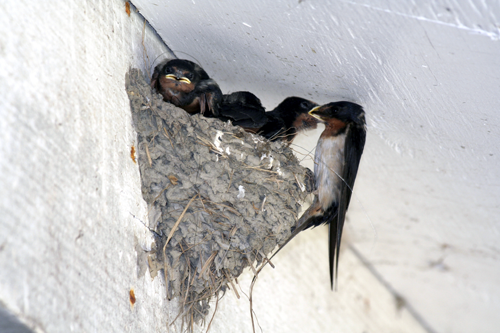
by Alex A. Kecskes
Variously known as martins, mud swallows, cliff swallows or barn swallows, these slender, colorful birds are small--just five to eight inches long--yet they often create a big nuisance for homeowners. Only proven effective bird deterrents will keep them away.
More than half a dozen swallow species roam North America. They prefer the safety and security of lofty areas and will build their mud nests under overhangs, beams, window jams and the ledges of homes. They’ll also attach their nests to garages, patio covers, fixed awnings and gazebos—particularly on textured surfaces like rough-sawn wood, stucco, masonry and concrete. They look for mud and drinking water and will mix sand, grasses, hair and feathers with mud to build their vertical clusters of gourd shaped nests. To keep them away from your home, you’ll need an effective bird deterrent strategy.
If you have swallows around your home, you’ll no doubt have encountered mud nests, debris and bird droppings. Like many bird droppings, swallow droppings can carry any of 60 known diseases. Fallen swallow nests can easily be picked up by a curious pet or child.
You may be tempted to remove swallow nests but the birds are classified as migratory and insectivorous under the Migratory Bird Treaty Act of 1918. Swallows are also protected by state regulations, which means you can be fined if you harm them or disturb their nests. The point is, once swallows have staked claim to your home, you’ll have to wait until they leave to remove the nests. And scrapping off mud nests can permanently mar your siding or paint.
Obviously, the strategy to employ is to discourage them from building nests on your property in the first place. And one of the most effective ways to keep swallows away is through the use of Sonic Bird Deterrents.
Sonic bird deterrents use a swallow’s natural fear of predators. They generate distress and predator calls that make swallows too nervous to build nests. One commercially available system can repeat these calls every 10 minutes. Not to worry, the sounds merely resemble natural birdcalls to humans. Unlike other bird sonic devices whose high-pitched ultrasonic noises irritate pets, the best sonic units won't bother pets. You can set these units’ volume control to generate from 65-105 decibels, and you can program them to turn on or off at night.
The best sound bird deterrents come with a built-in speaker that protects up to an acre of your property. You can add more speakers to protect larger areas (up to 5 full acres). The best bird sonic units are ruggedly constructed with U.V. protected materials to survive harsh sun weather conditions.
For best results, bird sonic units should be installed as close as possible to where swallows normally gather and build their nests. For homeowners that means under eaves, patio covers, gazebos and fixed awnings.
